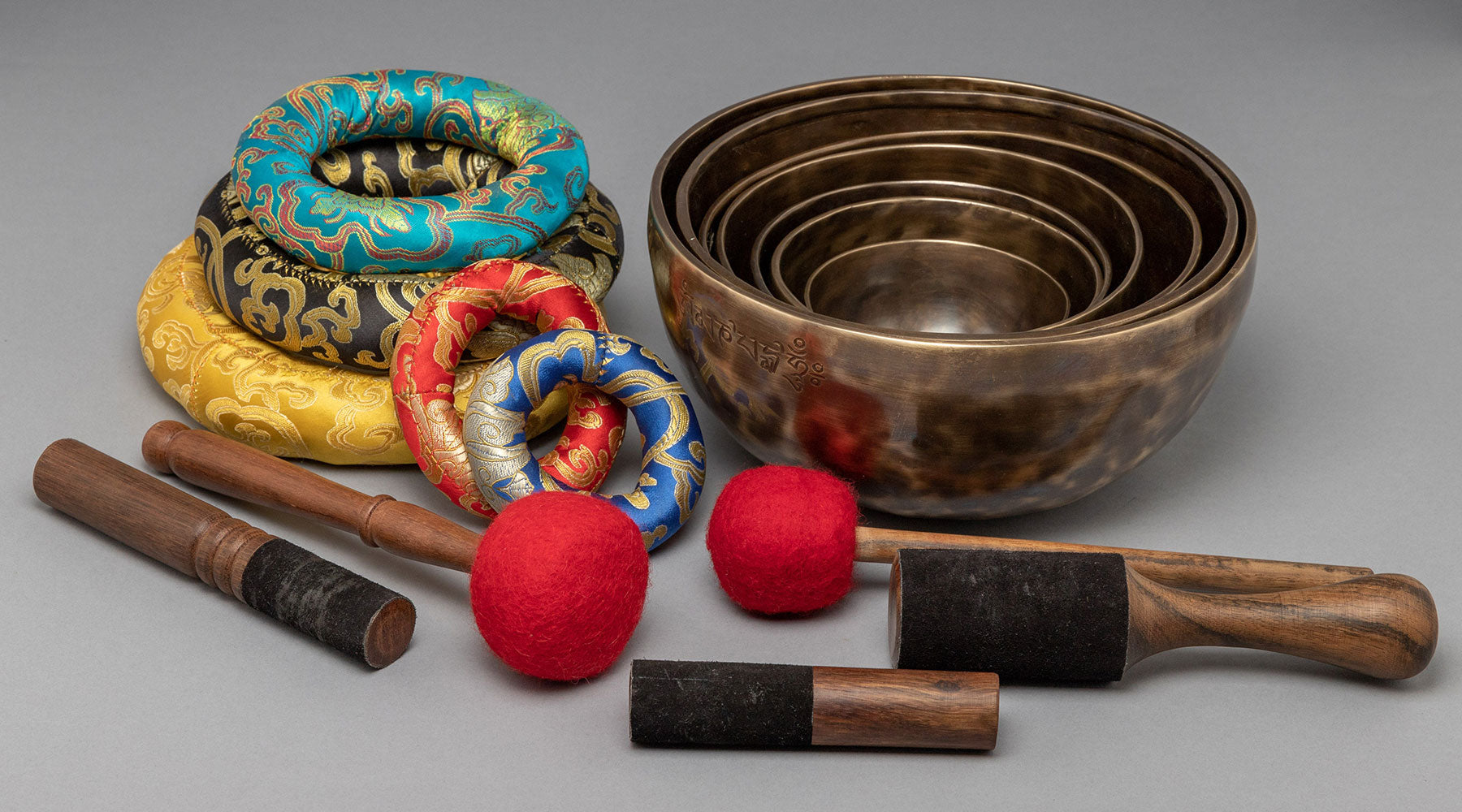Tibetan Singing Bowls and Their Spiritual Significance
In Buddhism, the Singing Bowl is more than just a musical tool; it embodies a profound symbol of the depth of dharma and the vibrational essence of reality.
Crafted from various metals, these bowls hold significance in Buddhist practices such as meditation, healing, and rituals. It's believed that their resonant tones can facilitate physical and spiritual healing, aiding in transformative experiences.
Key Takeaways
- Singing bowls are used in Buddhist meditation, healing, and rituals.
- They produce resonant tones believed to aid in spiritual transformation.
- Originating from the Himalayan region, their use has spread globally.
- Singing bowls are made from a unique blend of metals.
- Modern uses include music therapy, stress reduction, and chakra balancing.
Origins and Evolution
Click here to view our Singing Bowl with Handle
Singing bowls have an enigmatic origin, believed to trace back to the Himalayan regions encompassing Tibet, Nepal, and India. Initially crafted in these areas, they were employed by Buddhist monks primarily for meditation and ceremonial uses.
The tradition of making and utilizing singing bowls has been transmitted through generations, with each bowl meticulously handcrafted to produce distinctive sounds.
These sounds are more than mere musical tones; they are regarded as energy medicine conducive to healing and spiritual advancement.
Once guarded as esoteric wisdom among Buddhist monks, the ancient knowledge of singing bowls has been disseminated globally, integrating into diverse spiritual and therapeutic practices. Ceremonies.
Spread to the West
The journey of singing bowls to the Western world reflects a narrative of cultural exchange and spiritual exploration. During the latter part of the 20th century, as curiosity about Eastern spirituality burgeoned, so did the allure of singing bowls.
The Tibetan diaspora played a pivotal role in this dissemination, with monks and practitioners carrying their traditions and wisdom, sharing the profound spiritual instruments of their homeland.
Western intrigue with singing bowls was propelled by a burgeoning interest in meditation, yoga, and alternative healing modalities. People were captivated by the bowls' distinct sounds, seeing in them a means for relaxation, meditation, and personal development.
Today, singing bowls are commonplace in yoga studios, meditation centers, and households worldwide, serving as a conduit between the ancient and the contemporary, the spiritual and the practical.
Sound and Meditation
The sound emitted by singing bowls is central to their application within Buddhist practice. With their rich overtones and profound resonance, these bowls are believed to facilitate deep meditation, aiding practitioners in attaining a state of profound relaxation and mental clarity.
Often likened to the primordial sound of the universe, the sound encapsulates the Buddhist principle of śūnyatā, signifying emptiness.
Singing Bowl Therapy
In singing bowl therapy, practitioners utilize bowls with specific frequencies to target various areas of the body or aspects of the mind and spirit. During the therapy session, bowls may be placed directly on or near the client's body to allow the vibrations to penetrate deeply.
- Physical Healing: The vibrational energy emitted by singing bowls is believed to aid in healing physical ailments by improving blood circulation, reducing muscle tension, and bolstering the immune system.
- Emotional Balance: The sound frequencies can assist in releasing emotional trauma and fostering a state of dynamic equilibrium. This can be particularly beneficial for managing stress, anxiety, and depression.
- Spiritual Awakening: Incorporating singing bowls into meditation and spiritual practices can facilitate a profound connection with the self and the universe, fostering spiritual growth and enlightenment.
In therapeutic contexts, practitioners may position singing bowls in close proximity to the client's body, enabling them to feel the vibrations directly. This approach is thought to be effective in alleviating tension, boosting blood circulation, and catalyzing the body's natural healing mechanisms.
Singing Bowl Frequency
The notion of healing frequencies posits that particular tones can impact the body's energy centers or chakras, facilitating physical, emotional, and spiritual healing.
Although the exact frequency emitted by a singing bowl can differ depending on factors such as its dimensions, form, and material composition, specific frequencies are commonly linked to distinct therapeutic outcomes.
- 432 Hz: Often dubbed as the natural frequency of the universe, 432 Hz is believed to facilitate emotional release and harmonization with the natural world. Bowls tuned to this frequency might aid in alleviating anxiety and nurturing inner peace.
- 528 Hz: Referred to as the "Love Frequency," 528 Hz is linked to the repair and healing of DNA, transformation, and miraculous occurrences. It is thought to induce healing on a cellular level.
- 174 Hz: Regarded as the frequency of the Earth's heartbeat, this tone is utilized for pain relief and physical healing. It imparts a sense of security and affection, grounding the individual.
- 396 Hz: This frequency is associated with releasing guilt and fear and overcoming emotional obstacles. It is employed for grounding and resolving internal conflicts.
- 639 Hz: This frequency enhances communication, understanding, tolerance, and love. It is utilized in healing relationships and fostering connections with others.
Healing and Transformation
Within Buddhism, there exists a perspective that views the mind and body as intricately interconnected entities. The vibrations produced by singing bowls are thought to foster healing on both physical and mental levels.
These vibrations have the capacity to harmonize the body's energy systems, align the chakras, and foster physical and emotional healing.
Within Buddhist rituals and meditation sessions, singing bowls serve multiple purposes. They signify the commencement and conclusion of meditation periods, establish a sacred atmosphere, and support concentration and mindfulness practices.
During meditation, the continuous resonance of the bowl, often achieved by circling a mallet around its rim to produce a sustained sound, aids in sustaining focus. This sound functions as an auditory focal point, assisting practitioners in remaining present and avoiding distractions.
Types of Singing Bowl
| Type | Material Composition | Use in Practice |
| Traditional | Seven Metal Alloy | Meditation, Rituals |
| Modern | Bronze, Brass | Therapy, Personal |
| Crystal | Quartz | Personal, Therapy |
How to Use a Singing Bowl
- Striking: A simple strike to the bowl with a mallet can produce a rich tone.
- Rimming: Running the mallet around the rim creates continuous, harmonic sounds.
Tips for Beginners
- Choose the suitable bowl: Start with a medium-sized bowl, which is easier to play and balances the depth and volume of sound.
- Experiment with mallets: Different mallets can produce different sounds from the same bowl. Try various types to see which sound you prefer.
- Practice in a conducive environment: Find a quiet, undisturbed space where you can focus on the sound and vibration of the bowl without distractions.
- Be patient and mindful: Learning to play the bowl effectively takes time and practice. Approach it as a meditative practice, being present with the sound and the sensations it produces.
How to Make a Singing Bowl
-
Material and Composition:
Traditional Himalayan singing bowls are typically crafted from an alloy comprising seven metals, each corresponding to different celestial bodies: gold (Sun), silver (Moon), mercury (Mercury), copper (Venus), iron (Mars), tin (Jupiter), and lead (Saturn). This ancient amalgamation is believed to infuse the bowls with a broad spectrum of harmonic overtones and a deep, resonant quality. -
Manufacturing Process:
These bowls are traditionally handcrafted using a technique known as hammering, wherein the metal is heated and shaped through repeated pounding. This labor-intensive process contributes to the individuality of each bowl, as variations in hammering patterns and artisanal techniques influence the bowl's vibrational characteristics. -
Sound and Use:
Himalayan bowls are renowned for their intricate overtones and capacity to produce diverse sounds. The multi-layered tones make them ideal for meditation, sound therapy, and spiritual rituals, as they can induce profound states of relaxation and facilitate a connection with the divine.
Hand-beaten vs. Machine-made Bowls
- Hand-beaten Bowls: Hand-beaten singing bowls, primarily originating from the Himalayan region, are distinguished by their artisanal craftsmanship. Each bowl is unique, featuring tone, pitch, and appearance variations. The hand-beaten process produces a fuller sound with greater depth and complexity, rendering these bowls highly prized for their spiritual and therapeutic properties.
- Machine-made Bowls: Machine-made singing bowls, crafted from metal or crystal, offer more consistency in shape and tone but lack the distinctive character of hand-beaten bowls. They are often more budget-friendly and may suit beginners or individuals seeking a bowl with specific pitch requirements.
Tibetan Singing Bowl Symbols
Tibetan Singing Bowls are often adorned with Buddhist symbols and motifs, each with spiritual significance. Among the most commonly seen symbols are:
- Mandala Designs: Representing the universe and spiritual journey, mandalas on singing bowls symbolize cosmic harmony and the interconnectedness of all life.
- Mantras: The prevalent mantra on singing bowls is "Om Mani Padme Hum," invoking the bodhisattva of compassion, Avalokiteshvara. This mantra is believed to cleanse the mind, body, and speech, enhancing the spiritual potency of the instrument.
- Eight Auspicious Symbols (Ashtamangala): These encompass the Endless Knot, Lotus, Dhvaja (victory banner), Dharmachakra (wheel of Dharma), Bumpa (treasure vase), Golden Fish, Parasol, and Conch Shell. Each symbol signifies different aspects of Buddhist teachings and the journey towards enlightenment.
- Buddha Figures: Some bowls may depict images of the Buddha or other deities as a reminder of the enlightened state practitioners aspire to attain.
The Singing Bowl is a potent instrument for meditation, healing, and spiritual endeavors in Buddhism. Its profound history and spiritual importance complement its practical utility in modern wellness and therapy.
The singing bowl retains significance, whether employed in traditional Buddhist rituals or contemporary contexts. A symbol of the search for inner peace and understanding in the modern world.


